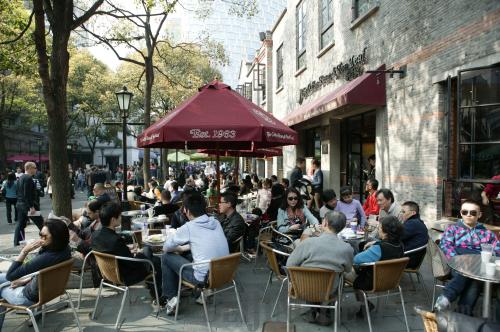|
 |
|
TAKING IT EASY: Xintiandi—with its rich historical and cultural attractions and relaxing atmosphere—is a hotspot among travelers and local residents (CFP/WANG PAN) |
The Peace Hotel, one of Shanghai's earliest hotels established more than 100 years ago, also stands proudly along the Bund stretch. With a classical Western style, it was once known as the No. 1 Mansion in the Far East.
But two buildings that particularly stand out are the Customs House and former headquarters of the Hong Kong and Shanghai Banking Corp. (HSBC), now called the HSBC Building.
Built in 1927, the Customs House was a sister construction of the HSBC Building. The clock on the building's facade, known as Big Ching, is the biggest in Asia—its clock and bell mechanism were made according to the design of Big Ben in London. Tourists and residents who frequent the Bund can hear it play The East Is Red every quarter hour.
The HSBC Building is also a truly unique structure. Its three bronze doors and bronze lions were specially cast in Britain. The cast mold was destroyed after the lions were completed, making the two proud bronze beasts a rare find. The building's spacious business hall ceiling is adorned with eight colorful mosaic murals depicting architectural landscapes from eight world metropolises from the early 20th century, including Shanghai, Hong Kong, London, Paris, New York, Tokyo, Bangkok and Calcutta. The building was widely considered the most elegant from the Suez Canal in Egypt to the Bering Strait in eastern Russia.
Not far from the magnificent buildings of the Bund is Shiliupu Dock. With a history of 150 years, Shiliupu Dock used to be the largest in Asia. It also served as Shanghai's door to the outside world.
The name Shiliupu dates to 1860 during the late Qing Dynasty (1644-1911). In order to resist attacks from Taiping rebel troops, local officials organized 16 (shiliu) stores (pu) and commercial companies to help support public security and local affairs. The Shiliupu eventually grew into an important commercial dock.
Today, an observation platform overlooking large clusters of trees, and steel and glass structures are spread across Shiliupu, earning it the name "Cloud on the Huangpu River."
A curved waterfront terrace was also completed here, to fully present the Bund and all its features and fulfill citizens' wishes to "approach Huangpu River, approach the mother river."
When lunchtime rolls around, there's no better place to eat than Chenghuang Temple near Yu Garden—and there's no better snack to indulge in than small steamed buns.
Yu Garden is located in the northeastern section of old Shanghai, with Fuyou Road to its north, Anren Street to the east, and old Chenghuang Temple to the southwest. Widely considered the most beautiful garden south of the Yangtze River, Yu Garden was built more than 400 years ago, in 1559, as a private garden. The garden—a legacy of the Ming Dynasty (1368-1644)—is the only one remaining in the old section of the city.
The garden has more than 40 scenic spots, including pavilions, terraces, stone fixtures and steles, and ponds, all in the architectural style from the Ming and Qing dynasties (1368-1911).
After New China was founded, the Shanghai Municipal Government launched a large-scale renovation of the garden. In February 1982, the State Council listed Yu Garden as a key cultural relic.
And just as important as the architecture and sights of Yu Garden is the food—specifically Nanxiang small steamed buns served in the garden. The steamed buns are made of white flour and filled with chopped meat. The fillings are mixed with liquid from chicken and pork soup instead of artificial flavoring, with a small amount of grinded sesame seed sprinkling and crab roes, spring bamboo or shelled shrimp according to the season.
A great way to spend the afternoon after a hearty lunch is a stroll through Tianzifang, an art street rebuilt in a labyrinth of narrow passages and old stone houses.
| 